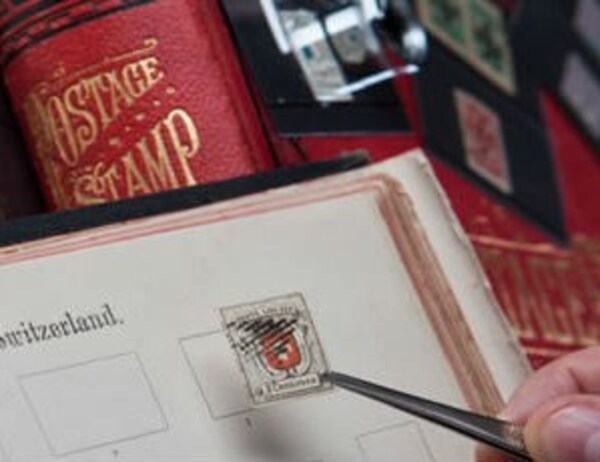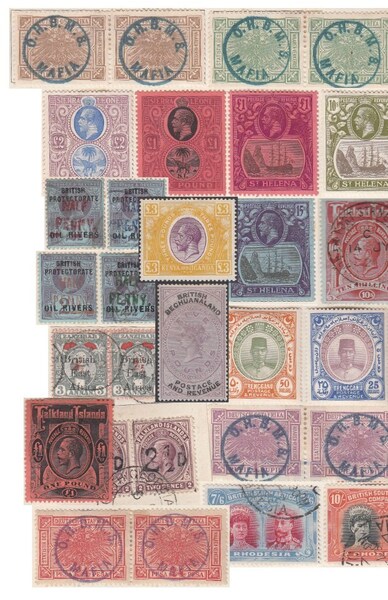As a teenager in the early 1980s I worked in a stamp shop. One fateful day a gentleman arrived with a collection of Great Britain stamps he wanted to sell. The lovely hingeless album contained everything between 1937 and 1970, including all the best stamps such as the various “Castle” high values, all the different definitive sets including watermark errors, and the Commemorative sets with phosphor sorting bands across the surface. I checked all the best stamps and found everything to be in perfect never hinged mint condition. I talked to my boss and we made a good offer. The gentleman said he’d consider our price whilst he had something to eat and we helpfully suggested a nearby café.
An hour later he returned and accepted our offer, which was a lot of money at the time. The following week I began to take the best sets out of the albums to add to our stock… and discovered the owner had not spent that hour eating in our favourite café but instead had spent his time swapping all those expensive never hinged stamps for hinged ones…
The differences between hinging and not hinging mint stamps has been on my mind a lot recently, to the extent that having seen, for probably the thousandth time, a collection of stamps damaged by poor hinging, I posted a video called “How to Hinge Stamps” on Youtube. Clearly Beyonce and Ed Sheeran can relax, it will never be an internet sensation but I do hope a few collectors will find it helpful. At the start of the video I made it clear that I didn’t want to discuss whether putting a hinge on the back of a stamp was a good idea in itself, as that was a separate issue altogether. However I think it’s correct to say that an unused stamp which still has its gum is worth more, all other things being equal, if it had never had a stamp hinge affixed to that gum.
I started in the stamp business as a 14 year- old working in that stamp shop on Saturdays and at stamp fairs on Sundays. This was the late 1970s and the importance of mint stamps being mounted or unmounted was by then very well- established.
I’ve always assumed that this differential came about as a result of hingeless albums being developed sometime after the war. As I considered writing this article I asked around but no one seems to know for sure, so I guess that whenever this two- tiering of mint stamp prices occurred, it probably occurred slowly. One “old- timer” (sorry) feels he first saw these two basic price differences in mint stamps reflected in lists of German stamps. That seems to make sense as I believe the German manufacturers were the first to produce attractive hingeless albums as plastic technology improved, but he also suspected that more valuable individual stamps may have been marketed as not being previously hinged long before then – the ‘fad’ only reaching out into the mainstream market as those fancy new albums came along.
As I work in the same office with seven other stamp experts I know that there are very few things we can all agree on. For example I prefer the appearance of older stamps displayed on album pages using stamp hinges, yet many of my colleagues like to see all stamps in some form of hingeless polymer mount, whilst I feel only modern stamps look at their best displayed that way!
Just like you I probably first fell in love with stamps because of their designs and not the paper they were printed on or the glue on the back! However if you take that most basic form of collecting a step or two further you will soon find yourself trying to differentiate between stamps which share the same design and you will find yourself considering inks, printing methods, papers, watermarks and in some cases different gums simply as tools to identify the stamp. Then, if you develop a taste for obtaining stamps which are as far as possible as close to the condition they were originally issued in, then in the case of unused stamps, if they were issued with gum at all you will want that gum to be in nice condition.
If the concept of ‘as close to issued condition’ is taken further along its logical path then as far as mint gummed stamps are concerned the fact that a small footprint is left by a stamp hinge may be too much for you to bear and you will find yourself seeking mint stamps which have never previously been hinged into a stamp collection. These two basic types of mint gummed stamps need to be adequately described and different firms use different terms. Some years ago we found that “unmounted” confused some of our overseas clients (as you can imagine the confusion caused by collections of unmounted mint stamps being described as being ‘mounted’ in hingeless ‘mounts’ or albums!) so at Sandafayre we tend to use “mint” or “M” to denote previously hinged, and “never hinged mint” or “NHM” to clearly denote that the stamp has never had a stamp hinge applied to it.
But what about stamps which were issued without gum? You can’t think of any? I’m not surprised as none of the catalogue producers are great at listing these consistently, for example the Indian 1854 4a blue and reds were not issued with gum, nor strictly speaking were the Western Australian 1854 1d blacks which were distributed to the different post offices with scissors, a pot of gum and a brush! In fact many stamps for use in atmospherically- challenging countries have been issued without gum. Recently we’ve described Chinese stamps from the 1930s and 1940s overprinted for use in various provinces and many of these were issued without gum. So this is where I’ll confess my logic hits a bit of a wall in terms of the ‘as close to issued condition’ argument as I really don’t think a collector should care if a mint stamp which was issued without gum has been hinged. Just like a postally- used stamp it should have no or little gum on the back, so we described those Chinese sets as “mint without gum as issued” whether they’ve been previously hinged or not.
But what mint condition should you collect? Before let’s say the early 1960s most stamps were mounted with stamp hinges and generally it’s harder to find the never hinged versions (not always of course, where for whatever reason large stocks held by dealers or Post Offices may have existed, for example), go a little earlier and the challenge to locate never hinged mint stamps increases further still, you may find (depending on what you collect) that when you get back to the 1940s trying to collect never hinged mint stamps can be no fun whatsoever as perhaps only 1 in 10 mint stamps are never hinged!
Move a little further back in time and it can all get very tiresome indeed… after all you must remember that this is a pleasurable pastime and you want to actually own some stamps! So in your efforts to locate a never hinged mint set from the 1920s you may find only perhaps 1 in 50 such mint sets come in this rarefied condition, so not only is the price for this set quite fairly inflated above what might not be a cheap set anyway, but they never seem to come along! Even if you are prepared to spend the money many older issues appear in never hinged condition so rarely that your hobby might simply grind to a halt! As a rough rule of thumb, and please remember I’m trying to sum up a very wide area of philately here (think Abu Dhabi, Falkland Islands, USA and Zululand…) the cost of collecting never hinged mint is perhaps two or three times higher than collecting the same stamps in hinged mint condition, so you pays your money and you takes your choice…
The “never hinged versus hinged” thing is not a ‘fad’. It was described that way to me by older experienced collectors almost 40 years ago, and in the 1990 edition of his “Fundamentals of Philately” the great L.N. Williams suggests the same, but in this small area I would respectfully disagree with them all. We as collectors seem to be happy with it, as long as we understand it.
So I’ll try to get back on track with three hopefully helpful opinions. Firstly, there is NOTHING WRONG with collecting hinged mint stamp, they look just the same as never hinged mint stamps but are in many cases more available, and available at a lower cost. Secondly, if you own never hinged mint stamps and apply a hinge to display them then you are likely to be reducing their resale value. Thirdly, if you own hinged mint stamps then as long as you do it carefully so as not to make the hinged area noticeably larger or in any other way damage the fabric of the stamp then go ahead and rehinge them into an album. This is something I know many advanced and wealthy collectors do with their expensive stamps.
There is another reason for you using stamp hinges or not, and that is your personal taste. You may own a beautiful hingeless album anyway, after all someone has gone to a great deal of expense to get that page looking right for when you finally find the stamps to put in it/on it. For similar reasons of display you may like those hingeless mounts which you can buy in pre-cut sizes or in strips, the album side is usually black and gummed on the reverse with a clear film to hold the stamps more or less in place. The market leaders are Hawid and Prinz but I guess others may be available. It is certainly possible to damage stamps if you are not careful in using these products and I may do a video about that too but utilised properly following the manufacturers guidelines they are excellent and attractive products.
Can I hear some of you asking about USED stamps? Well for purposes of taste you should mount them however you want but in my years of collecting and being in the stamp business I’ve not heard anyone complain about stamp hinges being used to mount postally used stamps, unless the hinge was perhaps obscuring a fault or had in some way damaged the stamp… again watch my video where I try to show how poor hinging technique can damage perforations, cause creasing and thins. Feel free to utilise hingeless mounts or hingeless albums for used stamps, it’s all about how you like to display them.
I’ve tried to give an overview of stamp hinging versus hingeless mounting but whatever you do first practice with cheap stamps to make sure you don’t damage anything valuable, and ask your favoured stamp supplier for advice. Clearly throughout I’m advocating proper philatelic products to display your stamps, do not employ glue sticks, sticky- tape, pins, photo- corners, sticky photograph albums and all the other ill- advised things I’ve seen to do the job (and I’m sure I’ve not seen it all yet!)
Many thanks for reading this far, I hope it’s been helpful! Happy Stamping!


 General
General
 General
General
 General
General